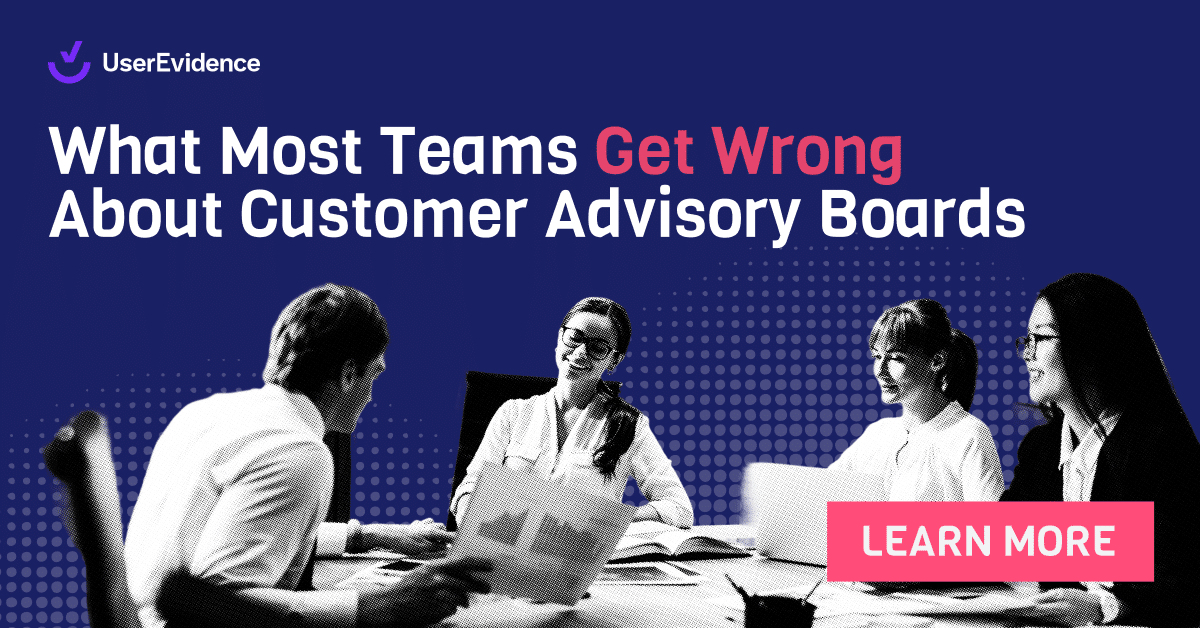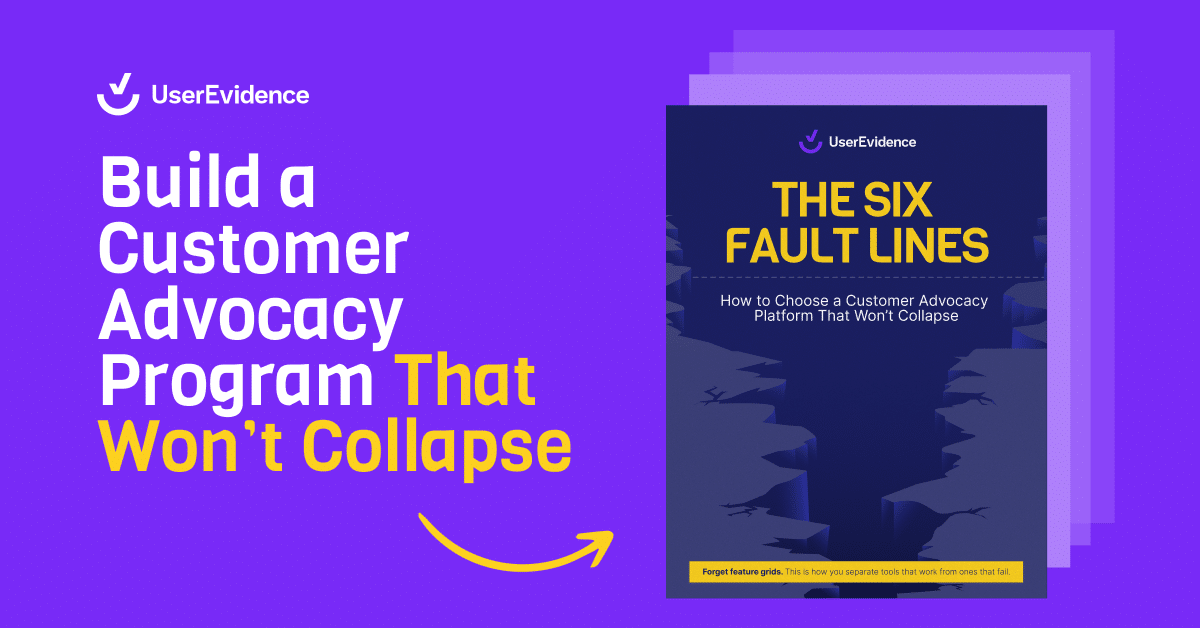In our recent research for the 2025 Customer Marketing Technology Landscape Report, we found that there are some key shifts happening in the customer marketing and advocacy landscape––the roles, the technology, and the industry itself. Now…do the job postings reflect that? We read into 100 recent CMA job postings to see what they could tell us about how the expectations of the role are changing.
Customer Advocacy Roles
For years, “customer advocacy” basically meant lining up a reference call or grabbing a nice quote for a case study. Now? Advocacy is bigger, smarter, and way more strategic. The best teams are building programs that scale—looping in customer champions across referrals, communities, content, and social proof––and gamifying their advocates’ experiences along the way. It’s not just about checking a box. It’s about driving real impact across the entire customer lifecycle. And the old playbook isn’t holding up: according to the research we did for our Evidence Gap Report, over half of sellers still rely on 1:1 references, even though buyers rank them among the least trustworthy forms of proof. It’s time for advocacy to evolve, and the jobs-to-be-done in these recent job postings reflect that.
Here are the aggregate data and takeaways from 26 customer advocacy job postings from 2025.
Customer Advocacy Key Responsibilities
Across roles and industries, customer advocacy responsibilities consistently revolve around elevating customer stories to drive influence, loyalty, and revenue. Here’s what stands out:
Customer Evidence Programs
- Nearly all roles focus on managing and scaling customer evidence programs like case studies, testimonials, reference calls, peer reviews (G2, Gartner), customer videos, and event participation.
- Many advocate managers are tasked with recruiting, nurturing, and tracking advocates in centralized platforms (e.g., Zealot, ReferenceEdge, Orca, Influitive (legacy customers only), SlapFive).
Content Creation & Storytelling
- Strong emphasis on collaborating with marketing to produce success stories and thought leadership.
- Job descriptions frequently mention the need to “make customers heroes” across formats—think: videos, blogs, speaker decks, and press quotes.
Cross-Functional Collaboration
- Advocacy sits at the intersection of marketing, sales, customer success, and product.
- Several roles call for proactive coordination with executives, product marketing, events, growth teams, and analyst relations.
Community Engagement & Events
- Many employers want advocacy professionals to support customer communities, user groups, customer advisory boards (CABs), and speaking programs.
- A few roles include white-glove onboarding of advocates and planning recognition programs or awards.
Customer Advocacy Salary Ranges
Among the postings that disclosed compensation, we saw the following:
Customer Advocacy Salary Trends
Overall Range: $80,000 to $298,000 USD annually
Common Band: $100,000 to $150,000, often tied to B2B SaaS advocacy manager roles
Mid–Senior Roles:
- Managers: $83,000 – $147,000
- Senior Managers: $120,000 – $239,000
- Directors & Heads: $180,000 – $298,000+
A note: We noticed that advocacy roles supporting more technical customers (think: AWS developers) tended to have higher salaries, thus bumping the band higher on average for the Sr. Manager and Directors & Heads category.
Customer Advocacy Reporting & Team Structure
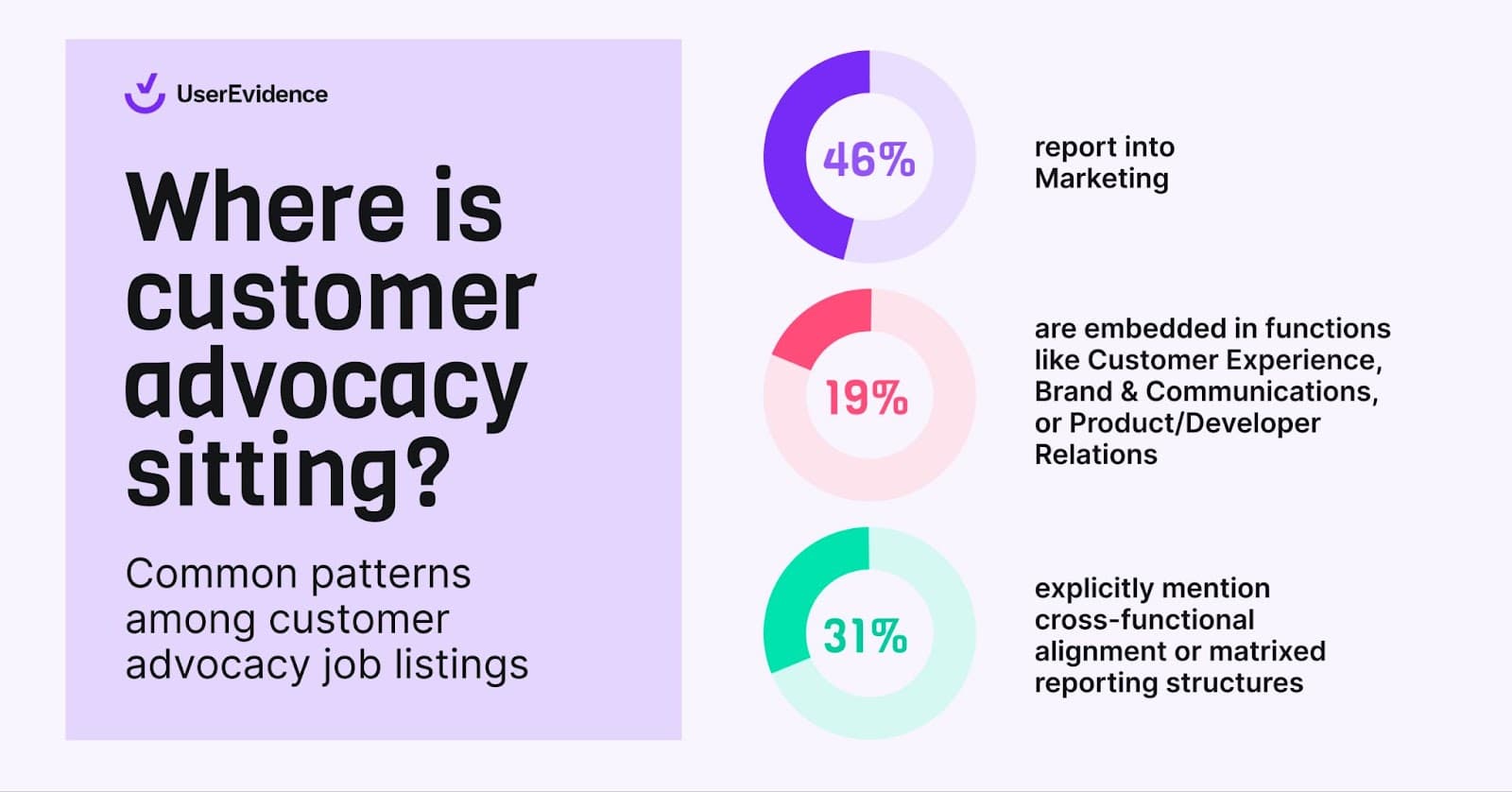
Common Patterns:
- Nearly half of advocacy roles (46%) report directly to marketing leaders such as VPs or Directors of Corporate, Product, or Field Marketing.
- About 1 in 5 (19%) are embedded in functions like Customer Experience, Brand & Communications, or Product/Developer Relations.
- 35% of director-level roles or above manage global advocacy programs, including regional leads and CAB oversight.
- 31% explicitly mention cross-functional alignment or matrixed reporting structures, reinforcing advocacy’s role in both brand and revenue strategy.
Customer Advocacy Goals & KPIs
Customer advocacy roles are becoming increasingly data-driven. Here are recurring performance metrics and objectives that we saw across these listings:
Advocate Activation Metrics
- # of active advocates
- # of reference calls, stories, or speaking engagements fulfilled
- % of top accounts with identified advocates
Impact on Pipeline and Brand
- Influence on revenue, closed-won deals, and lead generation velocity
- Increases in peer reviews, customer satisfaction scores, and community participation
Program Health & Engagement
- Engagement in CABs, communities, and events
- Growth in customer content libraries
- Responsiveness and utilization of advocate platforms and CRMs
Some companies tie advocacy to broader org OKRs like “category creation,” “brand visibility,” “analyst engagement,” and “customer sentiment.”
Final Takeaways on Customer Advocacy Roles
- Customer advocacy is increasingly strategic, no longer just a “nice to have” in marketing—it’s about influencing revenue, accelerating trust, and enabling GTM motion.
- Roles span marketing, community, and customer success, requiring hybrid skills in content, relationship-building, data analysis, and operations.
- Salaries are competitive, especially where advocacy aligns with brand storytelling, thought leadership, and executive programs.
- The rise of tools like Zealot, Orca, SlapFive, ReferenceEdge, and peer review platforms is shaping a more tech-enabled, measurable approach to advocacy.
Customer Marketing
There’s no denying that customer marketing has seen a massive shift in the past 5 years. What used to be a pretty niche role—mostly wrangling references and cranking out a few case studies—has morphed into a full-blown strategic function. Today’s customer marketers are expected to influence everything from onboarding and education to advocacy, retention, and expansion. And cross-functional collaboration with the entire GTM org to influence pipeline isn’t just a nice-to-have––it’s a must. Forrester recently reported that customer marketing teams now routinely coordinate with demand and ABM efforts, operating across the entire funnel rather than solely post-sale comms. And with that bigger scope comes bigger expectations: more efficiency, more measurable impact, more alignment with revenue goals.
Here are the aggregate data and takeaways from 82 customer marketing job postings from 2025.
Key Responsibilities for Customer Marketers
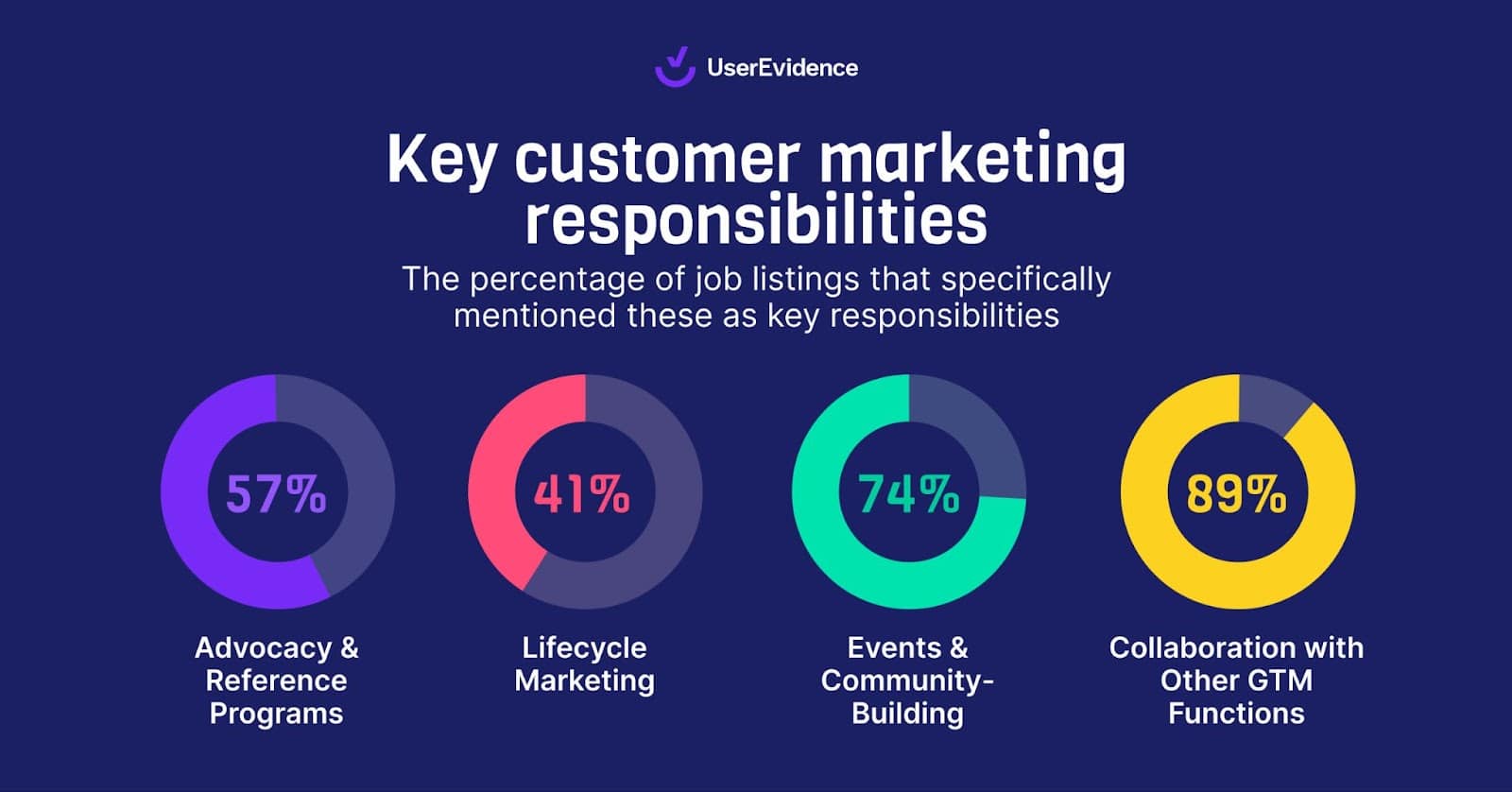
Customer marketing roles span a broad range of focus areas, but some consistent themes emerged:
1. Advocacy, Reference, and Customer Evidence Programs
24 roles mention “reference…” (e.g. “managing a pipeline of customer references”), and 23 mention “advocacy…” (e.g. “building an advocacy program”)
- Build and manage customer reference and customer evidence programs, including case studies, testimonials, peer reviews (e.g., G2, Gartner), and speaker engagements.
- Identify and nurture advocates through ambassador, referral, and loyalty programs.
- Manage review generation and collecting, curating, and sharing customer evidence efforts (using platforms like UserEvidence, Peerbound, and Deeto.)
2. Lifecycle and Campaign Execution
34 roles explicitly mention “lifecycle” in the description. That’s roughly 41% of the roles referencing lifecycle-focused responsibilities or programs.
- Develop multi-touch lifecycle journeys, leveraging segmentation and personalization across email, in-product, SMS, webinars, and newsletters.
- Drive adoption, retention, expansion, and upsell/cross-sell via triggered and milestone-based campaigns.
- Map customer journeys and create content for onboarding, adoption, and renewal.
3. Events and Community Building
61 roles in total mention either events or community. That’s 74% of the listings.
- Lead customer participation in events such as user conferences, panels, and roundtables.
- Build and support customer advisory boards (CABs), user groups, and branded communities.
- Partner with CS and product teams to drive event engagement and create post-event follow-ups.
4. Collaboration with Other GTM Functions
73 listings explicitly reference collaborating with other go-to-market functions (Sales, Customer Success/CS, or broader Marketing teams). That means nearly 89% of the listings call out cross-functional partnership as part of the role.
- Collaborate with Sales, Product, CS, RevOps, and Content to align messaging and revenue goals.
- Contribute customer insights to influence GTM and product strategy.
- Develop reporting structures for campaign attribution, NPS, and engagement health scores.
Customer Marketing Salary Trends
Overall Range: $64,000 to $240,000 USD annually.
Common Band: $110,000 to $155,000, often tied to B2B SaaS roles.
Mid-Senior Roles:
- Managers: $100,000 – $140,000
- Senior Managers: $130,000 – $170,000
- Directors: $160,000 – $240,000+
Reporting Lines & Team Structures
Most Common Reporting Lines:
- Reports into: Marketing leadership (e.g., VP of Marketing, Director of Brand/Content, Head of Growth, or Product Marketing)
- Frequent dotted-line alignment to: Customer Success and Sales teams.
Team Composition:
- Some roles are standalone; others manage 1–2 direct reports or cross-functional pods (e.g., campaign specialists, analysts).
- Larger orgs often embed customer marketing within Growth or Lifecycle teams alongside operations and analytics.
- Executive- or enterprise-level roles are often more matrixed, working across regions and product lines.
Customer Marketing Common Goals & Metrics
Customer marketing roles are heavily performance-driven. Metrics typically fall into these buckets:
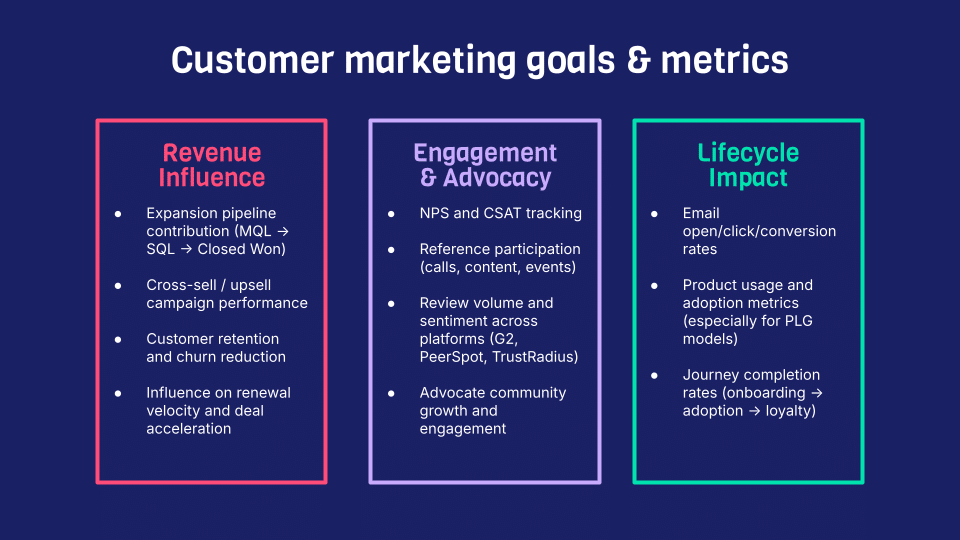
What All of This Means For CMA Pros
In many ways, what we’re seeing isn’t just an evolution—it’s a revolution in how customer marketing and advocacy professionals drive growth. Job descriptions are demanding more strategic vision, deeper cross-functional influence, and data-driven accountability than ever before. And that’s a good thing: higher impact, bigger pipeline contribution, and elevated standards mean these roles finally get the spotlight they deserve—and that our customers reap the benefits of more thoughtful, measurable programs at every stage of their journey.
But with higher expectations for these roles comes the need for better tooling and more comprehensive platforms. Our 2025 Customer Marketing Technology Landscape Report unpacks the latest trends, tools, and platforms powering today’s top teams—everything from advocacy automation and community hubs to full-funnel lifecycle engines.
